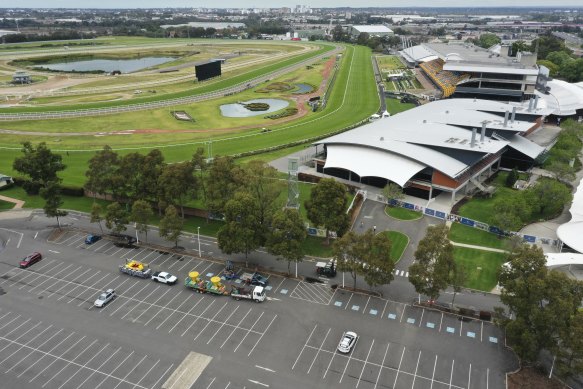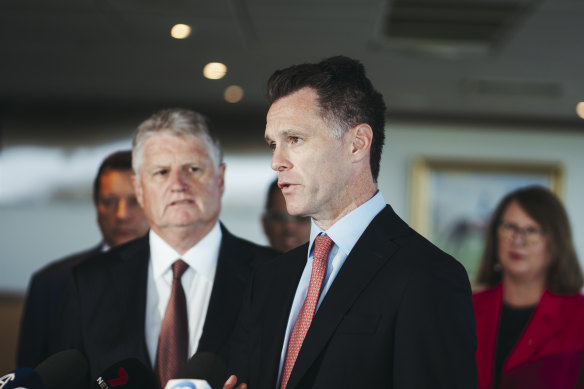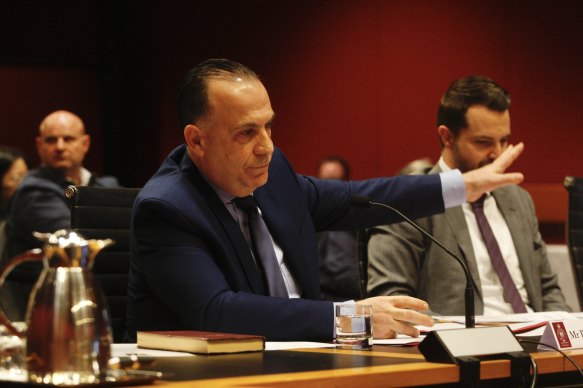This was published 11 months ago
Rosehill ‘megacity’ plan hangs by a thread as internal divisions laid bare
By Michael Koziol
The much-hyped proposal to sell Rosehill Racecourse to create a “megacity” of 25,000 new homes has been dealt another blow after two directors of the Australian Turf Club publicly accused their own organisation of poor governance, disputed the sale would generate a $5 billion dividend, and predicted their members would veto the plan.
Internal divisions were laid bare at a parliamentary inquiry as ATC board directors Caroline Searcy and Timothy Hale said they had never been provided a formal valuation showing the site could be worth $5 billion. Hale, a senior counsel specialising in property development law, said he had “never accepted” that figure and had no faith it was correct.

The Australian Turf Club owns Rosehill Racecourse near Parramatta.Credit: Rhett Wyman
However, Racing NSW chief executive Peter V’landys, a proponent of the deal, said experts doing due diligence for his organisation had advised the 60-hectare site could generate up to $23 billion over 35 years if sold off gradually.
V’landys rubbished assertions made in earlier hearings that Racing NSW had initiated the Rosehill sale, or that it would pocket the proceeds. “We never ever said that we wanted to take the money, we said we wanted oversight [of how it was spent],” he said.
At times the inquiry witnessed fiery exchanges between V’landys and upper house member Mark Latham, with the Racing NSW boss accusing Latham – and others who made submissions to the inquiry – of making “wild allegations with no substance” and conducting a “deplorable smear campaign” against him.
But the barrage of claims and counter-claims lifted the veil on the bitter undercurrent in NSW racing, and anger over the power V’landys and his governing body are believed to wield.

NSW Premier Chris Minns with ATC chair Peter McGauran announcing the plan to develop Rosehill Racecourse into a “mini-city” for 25,000 new homes in December last year.Credit: Dion Georgopoulos
Appearing separately, Searcy said ATC chairman Peter McGauran and corporate relations director Steve McMahon were wrong to engage Premier Chris Minns about the proposal in October 2023 before they briefed the rest of the board. Searcy said it was surprising and “certainly from a board point of view it’s perhaps not the best governance”.
She said a press conference announcing the potential deal in December, featuring Minns, McGauran and several government ministers, was also not right and “probably a negative in terms of the racing industry effectively being told we’re selling”.
Minns defended the proposal on Friday as the inquiry began, reiterating his fear that Sydney would become a “city with no grandchildren” unless it built more housing, and saying proponents of the deal such as V’landys should not have their “head taken off” for being open to new things.
“This culture in Sydney that says everything has to be set in stone, nothing can change, is hugely detrimental to the city,” the premier said. “If we don’t adopt change in an international city like Sydney, we will be stuck in the mud.”

Racing NSW boss Peter V’landys at Friday’s inquiry into the potential sale of Rosehill Racecourse.Credit: Dean Sewell
V’landys echoed that view following Friday’s inquiry. “We want to help the government, naturally,” he told reporters. “Chris Minns is probably the best premier I’ve seen in my time, and if we can help them, we will.”
At the hearing, McGauran confirmed the current unimproved value of the 60-hectare Rosehill site was $1.6 billion, but said the addition of a metro station, along with residential rezoning and a staged sell-off, would push it much higher. “I’m yet to find any valuer or large-scale experienced property developer who disagrees with $5 billion,” he said.
McMahon said it would not devalue the site if the metro station at Rosehill was delayed beyond the mooted 2032 opening of Metro West – as recently reported by 2GB – but Hale contested this, arguing it would affect what developers would be prepared to pay up front.
“Overwhelmingly, the view amongst those [ATC members] who attend the races is strongly against the sale of Rosehill,” Hale said. “I would have thought a substantial majority will vote against the proposal if things stay as they are.”
McMahon confirmed he met members of the state government’s Sydney Metro review team in August 2023, where he was told 40,000 homes would be required to justify an additional metro station, and Planning Department secretary Kiersten Fishburn on October 25. He then met with Minns on October 30 and briefed Racing NSW on November 1, at which point confidentiality agreements were signed. The ATC board was not briefed until November 21.
McGauran acknowledged that during subsequent meetings with horse trainers, he argued one reason to sell Rosehill and move racing elsewhere was that race crowds were declining due to demographics and the “high Indian population” near Parramatta.
He denied Latham’s characterisation that he had said words to the effect of “there are too many Indians living in the Parramatta region”.
“That’s offensive in the way you phrase it … you’re suggesting that I might have a problem with Indian families,” McGauran said. It was purely an examination of the racetrack’s likely audience.
The inquiry also heard competing views on whether the historic brick pit at Olympic Park would be suitable for a new racetrack to replace Rosehill.
V’landys said he was confident a track around the brick pit could co-exist with endangered green and golden bell frogs that have stymied previous development proposals at the site. “I appreciate there are beautiful frogs there, but we can cohabitate with those,” he said.
Racing NSW was undertaking due diligence including ecological and engineering assessments, V’landys said, but early indications were the site could accommodate a track bigger than Rosehill. He added: “I will make it very clear that they will need a second track for this [sale] to proceed.”
But Richard Callander, chief executive of the NSW Trainers Association, said it was “fanciful” the former brick pit could be an alternative first-grade racecourse. “It would be a massive loss to the racing industry to lose Rosehill as a track,” he told the inquiry.
McGauran said he would suspend judgment on the brick pit’s suitability until assessments were complete. He said the ATC was also exploring other sites which he would not flag publicly.
Opposition planning spokesman Scott Farlow, who is chairing the inquiry, said Friday’s evidence showed the Rosehill deal “should be scratched”. The benefit to taxpayers had not been established, he said, and there were still legitimate questions about whose idea it was in the first place. “It seems a fantasy at the moment,” he said of the project.
Meanwhile, the Turf Club is progressing to stage 2 of its unsolicited proposal to sell the asset. If it “stacks up”, the ATC would seek commitment from the government on a metro station and rezoning, McGauran said, and then put the deal to members.
If they vote it down, “that will be the end of the proposal and the members’ decision will be respected”, he pledged.
Start the day with a summary of the day’s most important and interesting stories, analysis and insights. Sign up for our Morning Edition newsletter.